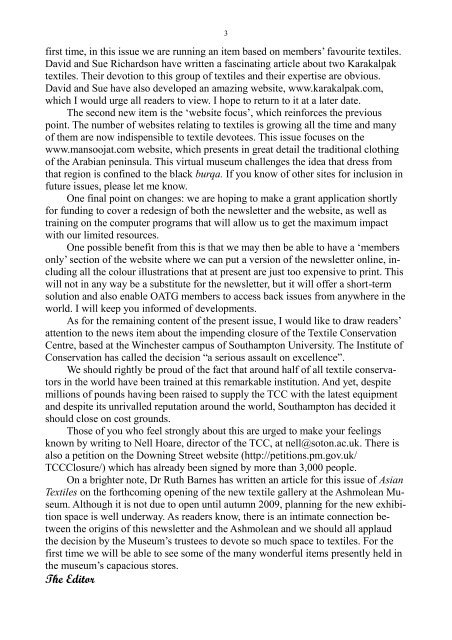Download - OATG. Oxford Asian Textile Group
Download - OATG. Oxford Asian Textile Group
Download - OATG. Oxford Asian Textile Group
You also want an ePaper? Increase the reach of your titles
YUMPU automatically turns print PDFs into web optimized ePapers that Google loves.
3<br />
first time, in this issue we are running an item based on members‘ favourite textiles.<br />
David and Sue Richardson have written a fascinating article about two Karakalpak<br />
textiles. Their devotion to this group of textiles and their expertise are obvious.<br />
David and Sue have also developed an amazing website, www.karakalpak.com,<br />
which I would urge all readers to view. I hope to return to it at a later date.<br />
The second new item is the ‗website focus‘, which reinforces the previous<br />
point. The number of websites relating to textiles is growing all the time and many<br />
of them are now indispensible to textile devotees. This issue focuses on the<br />
www.mansoojat.com website, which presents in great detail the traditional clothing<br />
of the Arabian peninsula. This virtual museum challenges the idea that dress from<br />
that region is confined to the black burqa. If you know of other sites for inclusion in<br />
future issues, please let me know.<br />
One final point on changes: we are hoping to make a grant application shortly<br />
for funding to cover a redesign of both the newsletter and the website, as well as<br />
training on the computer programs that will allow us to get the maximum impact<br />
with our limited resources.<br />
One possible benefit from this is that we may then be able to have a ‗members<br />
only‘ section of the website where we can put a version of the newsletter online, including<br />
all the colour illustrations that at present are just too expensive to print. This<br />
will not in any way be a substitute for the newsletter, but it will offer a short-term<br />
solution and also enable <strong>OATG</strong> members to access back issues from anywhere in the<br />
world. I will keep you informed of developments.<br />
As for the remaining content of the present issue, I would like to draw readers‘<br />
attention to the news item about the impending closure of the <strong>Textile</strong> Conservation<br />
Centre, based at the Winchester campus of Southampton University. The Institute of<br />
Conservation has called the decision ―a serious assault on excellence‖.<br />
We should rightly be proud of the fact that around half of all textile conservators<br />
in the world have been trained at this remarkable institution. And yet, despite<br />
millions of pounds having been raised to supply the TCC with the latest equipment<br />
and despite its unrivalled reputation around the world, Southampton has decided it<br />
should close on cost grounds.<br />
Those of you who feel strongly about this are urged to make your feelings<br />
known by writing to Nell Hoare, director of the TCC, at nell@soton.ac.uk. There is<br />
also a petition on the Downing Street website (http://petitions.pm.gov.uk/<br />
TCCClosure/) which has already been signed by more than 3,000 people.<br />
On a brighter note, Dr Ruth Barnes has written an article for this issue of <strong>Asian</strong><br />
<strong>Textile</strong>s on the forthcoming opening of the new textile gallery at the Ashmolean Museum.<br />
Although it is not due to open until autumn 2009, planning for the new exhibition<br />
space is well underway. As readers know, there is an intimate connection between<br />
the origins of this newsletter and the Ashmolean and we should all applaud<br />
the decision by the Museum‘s trustees to devote so much space to textiles. For the<br />
first time we will be able to see some of the many wonderful items presently held in<br />
the museum‘s capacious stores.<br />
The Editor

















